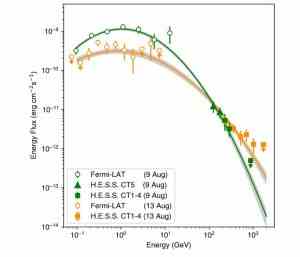Thermonuclear shock: Astronomers have for the first time been able to follow the nova of a white dwarf in the high-energy gamma-ray range. This revealed that the explosion at RS Ophiuchi, 7,500 light-years away, released enough energy to accelerate subatomic particles close to their theoretical maximum. Nova bursts are therefore efficient cosmic accelerators and thus a possible contributory cause of cosmic rays, as the team reports in “Science”.
A nova occurs when a white dwarf in a binary star system “over eats“: It sucks matter from its companion star until its mass exceeds a critical limit, the Chandrasekhar limit. As a result, a thermonuclear chain reaction occurs in its inflated envelope and it explodes. Such a nova released large amounts of radiation and can even in the sky with the naked eye become visible.
Unlike the supernova of massive stars, the white dwarf persists in a nova. It can therefore continue its stellar cannibalism – until the next nova.
A white dwarf explodes
Now astronomers have observed such a nova in the gamma-ray range for the first time. This was made possible by a nova outburst in the binary star system RS Ophiuchi, 7,500 light-years away. In it, a white dwarf and a red giant orbit each other at almost one and a half times the distance between the earth and the sun. Because the white dwarf continuously draws material from its companion, novae occur again and again – between 1889 and 2006 alone there were eight.
On August 8, 2021, optical telescopes again detected such a nova outburst at RS Ophiuchus. Astronomers worldwide were immediately alerted, including researchers at the HESS Observatory in Namibia and the team at NASA’s Fermi Space Telescope. This made it possible to follow the course of the cosmic explosion for a month using the gamma rays released.
Gamma rays of high energy and intensity
“This is the first observation of a nova in very high-energy gamma-ray light,” says Alison Mitchell from the University of Erlangen-Nuremberg, head of the HESS nova program. The type and intensity of this high-energy radiation now provides valuable insights into what is happening at the white dwarf. Among other things, the observations confirm that a nova also emits gamma rays and can achieve surprisingly high intensities.
As the astronomers determined, the gamma radiation from RS Ophiuchi reached high intensities up to the teraelectron volt range. The telescopes first registered an increase in the lower-energy gamma rays, followed by the higher-energy ones with a delay of around two days. Overall, the amount of gamma radiation released was so great that this nova must have accelerated protons and other particles to energies hundreds of times higher than previously thought for such explosions.

Carried away by the shock front
But where does this radiation come from? “The most likely scenario is that protons and other atomic nuclei will be sharply accelerated on the expanding blast shock front and collide with compressed material from the stellar wind that the red giant is blowing into space. This releases gamma rays,” explains co-author Brian Reville from the Max Planck Institute for Nuclear Physics.
Using optical data, the team estimates that RS Ophiuchi’s shock front hurtled out into space at several thousand kilometers per second. Overall, this nova could have an energy of 1043 erg released – equivalent to 0.3 masses of earth accelerated to 4,000 kilometers per second.
Close to the theoretical maximum
What was surprising: The particles of the material ejected by the nova were apparently accelerated to values close to the theoretical maximum. “The observation that the theoretical limit of particle acceleration can be reached in cosmic shock waves has enormous implications for astrophysics,” says co-author Ruslan Konno from DESY in Zeuthen. “It suggests that the acceleration process could be just as efficient in much more extreme cosmic explosions – the so-called supernovae.”
The exciting thing about it: This means that novae could also contribute more to cosmic rays than previously thought. This is present everywhere in the universe and consists of high-energy, fast-flying subatomic particles. However, the sources of this ubiquitous radiation have only been partially clarified. The new observations now reveal that explosions on white dwarfs could also contribute.
For RS Ophiuchi, the astronomers calculated: “Each nova event produces enough cosmic rays to fill a cube of one cubic parsec volume with an energy density of 0.1 electron volts per cubic centimeter – this is of the same order of magnitude as that produced by supernovae cosmic rays Radiation in our local galactic environment,” the team said. A cubic parsec corresponds to a cube with an edge length of about 3.2 light years. (Science, 2022; doi: 10.1126/science.abn0567)
Source: Max Planck Society, German Electron Synchrotron DESY

